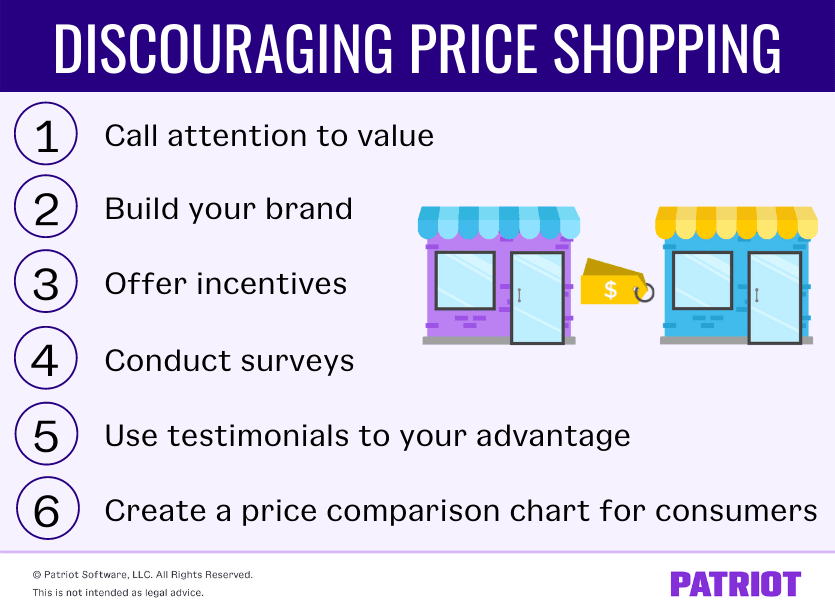Let’s face it: Consumers, regardless of age, gender, etc., want to find a good deal. And, some of them go above and beyond to find the best buy out there. To do this, consumers may partake in price shopping. Every business owner deals with price shopping, but how do you discourage it? Let us walk you through how to reduce price shopping so your business can increase customers without decreasing prices.
What is price shopping?
Price shopping is when consumers compare prices for similar services or products before making a decision. Price shoppers may also do comparison shopping. With comparison shopping, consumers look at other aspects along with prices, like features.
Consumers who price shop are looking for the best deal around, aka the best price they can find. Because they hunt for deals, they may mainly focus on just price instead of other factors, like value, features, etc.
Say you own a technology store. You and one of your competitors sell a similar computer. Your store sells the computer for $350 while your competitor sells a similar computer for $325. In this situation, a price shopper would purchase from your competitor solely because the price is cheaper, regardless of if your similar product has better features, reviews, etc.
How to discourage customers from price shopping 101
Of course, a business can only lower its prices so much before taking a major hit. So, what’s a business owner to do about price and comparison shoppers? Along with learning how to price products and services effectively (hint: brush up on margin vs. markup), you can keep a few strategies up your sleeve. To discourage comparison price shopping, try out these six tactics.

1. Call attention to value
Roughly 89% of comparison shoppers put the highest value on the lowest price. But as a business owner, you know that the lowest price does not equal the best value.
To discourage price shopping, put the value of your offerings right in front of consumers’ faces. That way, even if your prices aren’t as competitive as others, your potential customers can see what value your products or services deliver.
Call attention to value as much as you can with your offerings. And, tie value and price together so consumers can understand why you price your offerings the way that you do.
For example, you may charge more for a premium version of your product because it offers more features and flexibility for your customers.
Whatever you do, explain the value behind your offerings to potentially stop price shoppers in their tracks (and hopefully convince them to make a purchase from your business).
2. Build your brand
Brand awareness is a big part of why consumers go with one business’s products or services over another. And, it could prevent price shoppers from purchasing from your competitor if they recognize your business name and brand (and trust it).
To discourage price shopping comparison, make your brand well-known and build it up. To do this, you can:
- Tell your business’s story (and put it everywhere)
- Post on social media
- Set up Google My Business
- Take out ads
- Humanize your business
- Create a short, catchy slogan
- Have someone or something be the face of your company (e.g., mascot)
- Team up with other businesses (e.g., guest blog on other websites)
- Get involved in your community
The more you build up your brand and gain trust from consumers, the less likely they are to price shop with one of your competitors. If they know you and your company and you have a solid reputation, they may decide a few extra dollars isn’t worth it in the long run.
3. Create a price comparison chart for consumers
If you want to show consumers you have the best or fairest price in the game, consider creating a comparison chart for potential customers. A chart can help them visualize all of their options and see the value in your offerings.
In your chart, compare prices and value for you and your competitors. Show why a consumer should go with your company over another. And, be sure to include what makes you truly stand out from the competition aside from more bang for your buck (e.g., free and excellent customer support).
Showcase your chart in your marketing materials and on your business website so it can be one of the first things price shoppers see.
4. Use testimonials to your advantage
When consumers price shop, they typically start with an online shopping comparison by bouncing around from one website to the next. But with online shopping, you can’t see, touch, test out, etc. a product before purchasing it. The solution to getting price and comparison shoppers to purchase from you online? Testimonials.
Adding social proof, like testimonials, to your product pages shows consumers why they won’t regret buying from you over someone else. After all, 93% of consumers say that online reviews influence their purchase decisions.
Showcase excellent customer reviews in as many locations as possible, like on your website and social media pages. Don’t be afraid to also sprinkle testimonials in other places, like in email campaigns. Testimonials show why potential customers should purchase from you over anyone else. Not to mention, they spotlight the value your products or services offer.
Even if you don’t have the lowest price on the market, testimonials are a great way to reinforce the trustworthiness and quality of your business and brand.
On the importance of using testimonials to discourage price shopping, Karl Hughes, Founder of Draft.dev, said:
The best way to discourage customers from price shopping is to have a lot of customer testimonials available. When you have testimonials and reviews, it can prove to your new customers that the price is worth it. Testimonials can be what convince your customers to purchase.
5. Conduct surveys
Another tactic to use to stop price shoppers in their tracks is conducting surveys with current customers. With a simple survey, you can find out:
- Why a customer decided to purchase from you
- How they feel about your pricing
- Why a customer purchased from you over a competitor
- What they like about your offering(s)
There are endless questions you can answer with surveys for your business. Surveys can tell you a lot about your customers, their buying habits, and how you got a sale. Not to mention, they are an easy option for small business owners to find out more about their customers. You can then use said surveys to promote your business and find out exactly how to sell to price shoppers.
6. Offer incentives
Price shopping is all about finding the best deal, right? Correct. And chances are, people searching for deals are also looking for extra perks, too. To discourage price shoppers from solely looking just at prices, consider offering incentives to make them want to purchase from you.
Some small incentives you can offer include:
- Free shipping
- Free gift with purchase
- Exclusive discounts and offers
Offering incentives to consumers may make them feel like they’re getting the best deal, even if they’re paying a little more. So, don’t be afraid to offer an incentive here or there to entice people to make a purchase.
This is not intended as legal advice; for more information, please click here.




